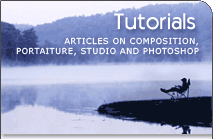This article belongs completely to Ed Shapiro, a professional photographer, who contributed a lot to the art. It is based on the content of a topic of forum. I have to thank Ed for covering this topic. I could not find any place where Ed gathered and published his knowledge, so I decided to extend the audience of the forum where he posted this topic. So here it goes...
Reflectors Vs. Flash
There is certainly more than one way to produce first class outdoor or natural light portraiture. I have been at it for a long time and have had the advantage of studying with many fine teachers in the field.
Working with diffusion panels, scrims and blockers is the ideal way to do outdoor portraits. By adding and subtracting light with all the scrims and gobos is a true art and yes, these methods are widely used in feature film production all the time. Problem is — in such productions there are crews of people to man and transport all the heavy weight gear which consists of very husky light stands and booms, sand bags and special spikes to tether all this stuff to the ground. Large aluminum frames are made to hold the reflector and diffusion panels which are laced into place through the grommets of the material being used.
In the midst of a wedding or a family group with children it is almost impossible to quickly work with an equipment array of that magnitude. With most medium duty light stands and conventional photographic light modifiers there is always the possibility of equipment falling or becoming airborne with even the slightest breeze. Vital images can be missed when there is too much equipment management to deal with. I have worked with an inverted “L” shaped rig to block overhead light and to create a good short lighting effect — filling in with reflectors or adding highlights with shiny reflectors from a distance — all good if you have the time and help.
My favorite system is extremely simple. I go out with a camera and a couple of lenses, a good tripod, a few Monte Illuminator products and an exposure meter and I always find the light. Often times no reflectors are needed because there is natural fill from nearby walls or fences.
Electronic flash fill can be practical for some types of work but there is always the danger of overfilling. If you want to minimize the depth of field by shooting at wide apertures, you might have to power down your flash unit beyond its range and utilize layers of diffusion material to arrive at a low enough power output. If you want to use your flash as a key light the same problem might occur. I use bare bulb and have achieved a reasonable facsimile of good portrait lighting. I place a piece of Rosco filter material over the flash tube to match the late afternoon or early morning light. Where there are higher levels of natural light, you may not have the higher range of synchronisible shutter speeds to accommodate the larger apertures in that some focal plane shutters have a maximum synch speed of 125th of a second or more — you might need a 250th or a 500th .
It is good to have a working knowledge of all these methods, in the event of having to shoot in a time frame that does not necessarily yield good lighting. PRACTICE! There is not only one way! What may work well in theory does not always work well in practice — You need to test your methods out before using them on an actual shoot. ![End of the article [end of the text]](http://www.romanzolin.com/img/misc/text_end_ed.png)





